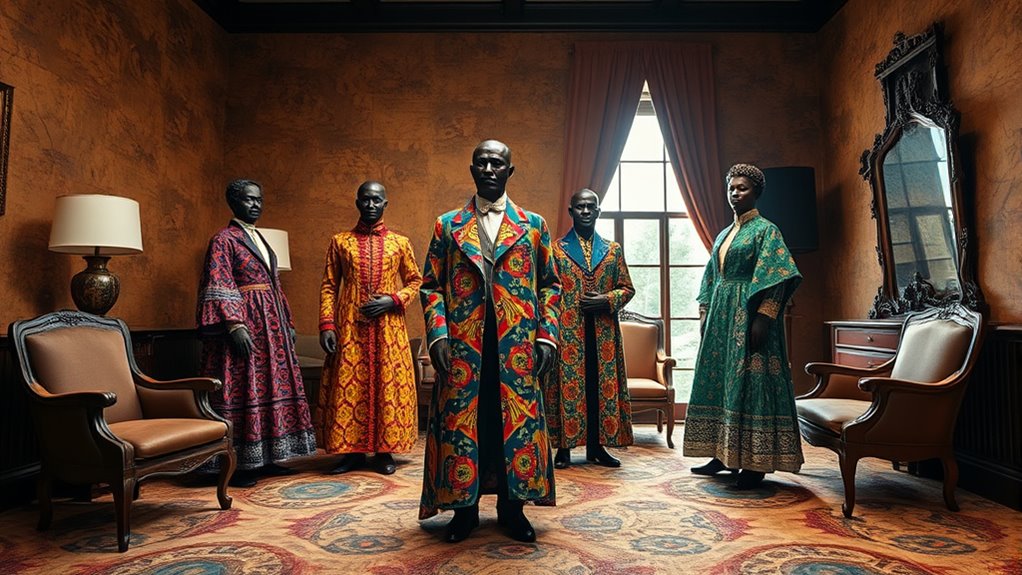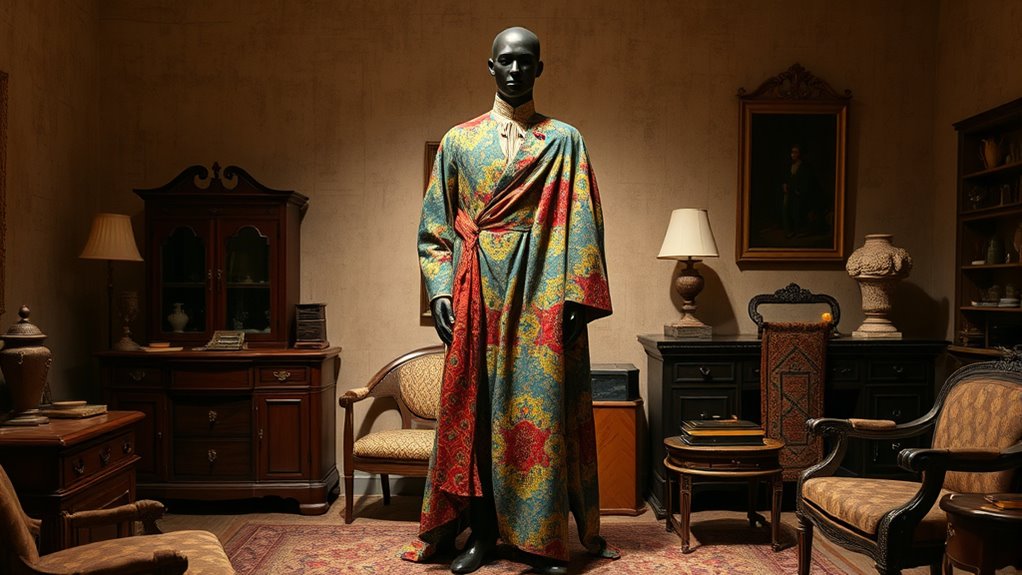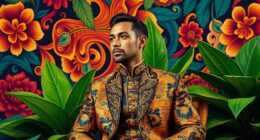Yinka Shonibare’s work challenges postcolonial narratives by using vibrant textiles, like Dutch wax fabrics, to symbolize cultural hybridity and resistance. His sculptures, often headless mannequins dressed in patterned fabrics, represent lost identities and marginalized voices, questioning traditional histories. Through symbolism, satire, and irony, he critiques colonial dominance and highlights the fluidity of cultural identity. If you keep exploring, you’ll uncover how his art invites reflection on the ongoing impacts of colonial histories and identities.
Key Takeaways
- Yinka Shonibare challenges colonial narratives by questioning traditional histories and exploring their influence on cultural identity.
- His use of vibrant fabrics like Dutch wax symbolizes cultural hybridity and the blending of colonial and indigenous traditions.
- Sculptural works featuring headless mannequins evoke themes of identity loss and marginalized voices within postcolonial contexts.
- Shonibare employs satire and irony to critique colonial dominance and reflect on the absurdities of colonial histories.
- His art promotes understanding of cultural resilience and the evolving nature of identity through symbolic visual language.

Yinka Shonibare’s work boldly challenges traditional narratives of colonialism and identity, inviting you to reconsider how history shapes culture. His art explores complex themes around cultural identity, revealing how history influences the ways societies see themselves and others. When you engage with his pieces, you notice how he uses artistic symbolism to communicate layered messages about postcolonial realities. His vibrant textiles, often Dutch wax fabrics, serve as visual cues that symbolize the blending and clash of cultures, highlighting how colonial histories are woven into everyday life. Through this, Shonibare prompts you to question the origins of cultural symbols and their evolving meanings in a postcolonial context.
Shonibare’s use of artistic symbolism is deliberate and powerful. His sculptures and installations often feature headless mannequins dressed in costumes made from patterned fabrics, representing a break from traditional portraiture and emphasizing the universality of identity. These figures stand as symbols for marginalized voices, reminding you that history’s narrative isn’t fixed; it’s fluid and open to reinterpretation. The absence of heads in his work suggests the loss of individual identity within colonial histories, urging you to think about how cultural identities are shaped by larger power structures. This visual language challenges you to see beyond surface appearances and understand the deeper stories intertwined with cultural artifacts. Additionally, his work emphasizes the importance of cultural hybridity as a means of resistance and resilience.
In his works, Shonibare draws attention to the hybridity that defines postcolonial identities. You notice how he combines Western classical references with African motifs, creating a dialogue between different cultural traditions. This fusion underscores that cultural identity isn’t static but a dynamic, ongoing process influenced by colonial histories. His installations often evoke a sense of satire and irony, making you reflect on the absurdities of colonial dominance and the resilience of cultural hybridity. You realize that his art doesn’t just critique colonialism but also celebrates the creative ways cultures adapt and survive after colonial rule.
Ultimately, Yinka Shonibare’s art invites you to see the ongoing impact of colonial histories on contemporary identities. His use of artistic symbolism and focus on cultural hybridity push you to question assumptions about race, nationality, and belonging. His work reminds you that cultural identity is complex, layered, and continually reshaped by historical forces. By engaging with his art, you become part of a larger conversation about postcolonial narratives—one that challenges you to rethink how history influences culture and how you perceive your own identity within a global context.
Frequently Asked Questions
How Does Shonibare Choose His Fabric Patterns?
You notice that Shonibare chooses fabric patterns rooted in textile symbolism and cultural hybridity. He often opts for Dutch wax prints, which blend African and European influences, reflecting postcolonial identities. His selection highlights the layered histories of colonized regions, emphasizing the complex cultural exchanges. By using these patterns, he invites you to explore themes of identity, colonial legacy, and the blending of traditions within contemporary art.
What Are the Main Influences on Shonibare’s Artistic Style?
You’re overwhelmed by a whirlwind of cultural hybridity and global influences that shape Shonibare’s style. His art is a vibrant tapestry woven from colonial history, African heritage, and Western aesthetics, creating a stunning collision of worlds. These diverse sources collide and blend, inspiring his bold use of fabric and iconic imagery. It’s this fusion that makes his work resonate across cultures, challenging perceptions and highlighting the complex dance of identity and history.
How Does Shonibare Address Colonial History Through His Art?
You see Shonibare address colonial history by exploring cultural identity and power dynamics through his art. He uses vibrant fabrics and historical references to highlight the complex relationships between colonizers and the colonized. By doing so, he challenges traditional narratives, revealing how colonialism has shaped cultural identities and shifted power structures. His work invites you to reflect on history’s lasting impact and the ongoing negotiations of identity and authority.
What Is the Significance of Victorian Costumes in His Work?
Victorian costumes in his work shout louder than words, acting as powerful symbols of fashion and cultural identity. You see, they represent the clash and blend of history, illustrating how colonial power and societal norms shape identities. By dressing figures in these elaborate garments, Shonibare exaggerates the influence of colonial history, making you question how fashion symbolizes cultural control and the complex layers of postcolonial identity.
How Does Shonibare’s Background Shape His Narratives?
Your understanding of Yinka Shonibare’s background reveals how his personal history and cultural identity shape his narratives. His Nigerian and British heritage influences his exploration of postcolonial themes, highlighting the complexities of identity and history. You’ll see that his work challenges stereotypes, blending Western and African cultures. By doing so, he prompts you to reflect on how cultural identity is constructed and how personal history informs broader societal stories.
Conclusion
You realize that Yinka Shonibare’s work challenges you to see beyond surface stories. His intricate costumes and layered symbols aren’t just art—they’re a call to question history and identity. The theory suggests postcolonial narratives reveal truths hidden by colonial silence. Maybe, just maybe, by confronting these stories, you can feel a deeper connection to those silenced voices. Shonibare’s art invites you to believe that truth, though complex, is worth uncovering.










